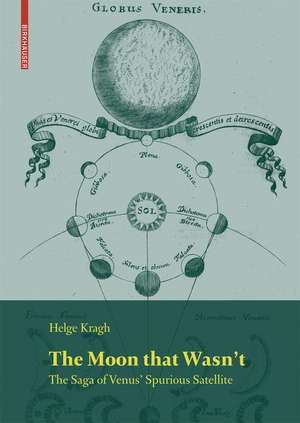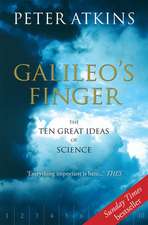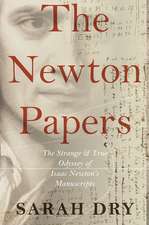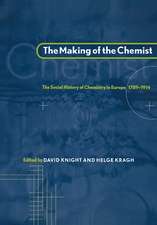The Moon that Wasn't: The Saga of Venus' Spurious Satellite: Science Networks. Historical Studies, cartea 37
Kurt Möller Pedersen Autor Helge Kraghen Limba Engleză Hardback – 18 sep 2008
Din seria Science Networks. Historical Studies
- 18%
 Preț: 796.31 lei
Preț: 796.31 lei - 15%
 Preț: 652.49 lei
Preț: 652.49 lei - 18%
 Preț: 787.15 lei
Preț: 787.15 lei -
 Preț: 385.25 lei
Preț: 385.25 lei -
 Preț: 489.30 lei
Preț: 489.30 lei - 15%
 Preț: 476.75 lei
Preț: 476.75 lei -
 Preț: 389.31 lei
Preț: 389.31 lei - 15%
 Preț: 699.59 lei
Preț: 699.59 lei - 15%
 Preț: 660.37 lei
Preț: 660.37 lei - 15%
 Preț: 531.59 lei
Preț: 531.59 lei - 24%
 Preț: 909.27 lei
Preț: 909.27 lei -
 Preț: 396.24 lei
Preț: 396.24 lei - 18%
 Preț: 903.17 lei
Preț: 903.17 lei -
 Preț: 382.36 lei
Preț: 382.36 lei -
 Preț: 395.25 lei
Preț: 395.25 lei - 15%
 Preț: 647.73 lei
Preț: 647.73 lei - 15%
 Preț: 702.87 lei
Preț: 702.87 lei - 15%
 Preț: 674.74 lei
Preț: 674.74 lei - 15%
 Preț: 655.60 lei
Preț: 655.60 lei - 15%
 Preț: 650.19 lei
Preț: 650.19 lei - 15%
 Preț: 644.82 lei
Preț: 644.82 lei - 15%
 Preț: 646.62 lei
Preț: 646.62 lei - 18%
 Preț: 1119.08 lei
Preț: 1119.08 lei - 18%
 Preț: 1135.46 lei
Preț: 1135.46 lei - 20%
 Preț: 595.48 lei
Preț: 595.48 lei - 20%
 Preț: 596.59 lei
Preț: 596.59 lei - 15%
 Preț: 649.06 lei
Preț: 649.06 lei - 15%
 Preț: 639.37 lei
Preț: 639.37 lei -
 Preț: 399.12 lei
Preț: 399.12 lei - 18%
 Preț: 1390.11 lei
Preț: 1390.11 lei -
 Preț: 361.03 lei
Preț: 361.03 lei - 18%
 Preț: 1395.63 lei
Preț: 1395.63 lei - 15%
 Preț: 642.36 lei
Preț: 642.36 lei - 15%
 Preț: 648.24 lei
Preț: 648.24 lei - 15%
 Preț: 649.06 lei
Preț: 649.06 lei -
 Preț: 392.37 lei
Preț: 392.37 lei
Preț: 567.63 lei
Preț vechi: 709.54 lei
-20% Nou
Puncte Express: 851
Preț estimativ în valută:
108.63€ • 117.96$ • 91.25£
108.63€ • 117.96$ • 91.25£
Carte tipărită la comandă
Livrare economică 18-24 aprilie
Preluare comenzi: 021 569.72.76
Specificații
ISBN-13: 9783764389086
ISBN-10: 3764389087
Pagini: 208
Ilustrații: XII, 199 p. 33 illus.
Dimensiuni: 165 x 235 x 18 mm
Greutate: 0.53 kg
Ediția:2008
Editura: Birkhäuser Basel
Colecția Birkhäuser
Seria Science Networks. Historical Studies
Locul publicării:Basel, Switzerland
ISBN-10: 3764389087
Pagini: 208
Ilustrații: XII, 199 p. 33 illus.
Dimensiuni: 165 x 235 x 18 mm
Greutate: 0.53 kg
Ediția:2008
Editura: Birkhäuser Basel
Colecția Birkhäuser
Seria Science Networks. Historical Studies
Locul publicării:Basel, Switzerland
Public țintă
Popular/generalCuprins
A moon or not? A century of confusion.- From climax to anticlimax.- Contemporary analysis and criticism.- A spurious but persistent satellite.- Closure: the discussion of the 1880s.- Conclusion, and a note on the satellites of Uranus.
Recenzii
From the reviews:
“The moon that wasn’t makes the reader aware of how the idea of a Venusian satellite retained its attractiveness not only in science but also in society … . well-produced, clearly organized, and supported by useful illustrations … and an extensive bibliography. … Helge Kragh must be congratulated for writing a solid historical study that portrays lesser known, second- or even third-rate astronomical researches and for offering … new case studies for philosophers of science to ponder.” (Jarosław Włodarczyk, Journal for the History of Astronomy, November, 2010)
“This book is an account of certain peculiar telescopic observations from the 1640s through the 1760s, and of the interpretations of them during this early period and later. … Kragh’s endeavor in this book is to give an account of the Venus-moon affair that is as complete as possible. His examination of the literature has been extensive … . He provides an extensive bibliography, identifying the many primary sources which he has consulted. He includes biographical sketches of the 23 chief characters in his story.” (Curtis Wilson, Aestimatio: Critical Reviews in the History of Science, Issue 8, 2011)
“The Moon That Wasn’t comprehensively reviews the literature relating to the search. … Kragh rigorously supports his narrative by extensive footnotes and references, and includes biographical summaries for two dozen of the prominent individuals associated with the controversy. … this volume contains extensive material of interest to historians … . Summing Up … . Professional and academic historians of science; general readers.” (D. E. Hogg, Choice, Vol. 46 (9), May, 2009)
“The moon that wasn’t makes the reader aware of how the idea of a Venusian satellite retained its attractiveness not only in science but also in society … . well-produced, clearly organized, and supported by useful illustrations … and an extensive bibliography. … Helge Kragh must be congratulated for writing a solid historical study that portrays lesser known, second- or even third-rate astronomical researches and for offering … new case studies for philosophers of science to ponder.” (Jarosław Włodarczyk, Journal for the History of Astronomy, November, 2010)
“This book is an account of certain peculiar telescopic observations from the 1640s through the 1760s, and of the interpretations of them during this early period and later. … Kragh’s endeavor in this book is to give an account of the Venus-moon affair that is as complete as possible. His examination of the literature has been extensive … . He provides an extensive bibliography, identifying the many primary sources which he has consulted. He includes biographical sketches of the 23 chief characters in his story.” (Curtis Wilson, Aestimatio: Critical Reviews in the History of Science, Issue 8, 2011)
“The Moon That Wasn’t comprehensively reviews the literature relating to the search. … Kragh rigorously supports his narrative by extensive footnotes and references, and includes biographical summaries for two dozen of the prominent individuals associated with the controversy. … this volume contains extensive material of interest to historians … . Summing Up … . Professional and academic historians of science; general readers.” (D. E. Hogg, Choice, Vol. 46 (9), May, 2009)
Textul de pe ultima copertă
This book details the history of one of astronomy’s many spurious objects, the satellite of Venus. First spotted in 1645, the non-existing moon was observed more than a dozen times until the late eighteenth century. Although few astronomers believed in the existence of the moon after about 1770, it continued to attract attention for at least another century. However, it has largely disappeared from the history of astronomy, and the rich historical sources have never been exploited. By telling the story of the enigmatic satellite in its proper historical context it is demonstrated that it was much more than a mere curiosity in the annals of astronomy – Frederick II of Prussia was familiar with it, and so was Bonnet, Kant and Voltaire. The satellite of Venus belongs to the same category as other fictitious celestial bodies (such as the planet Vulcan), yet it had its own life and fascinating historical trajectory. By following this trajectory, the history of planetary astronomy is addressed in a novel way.
Caracteristici
First book ever that recounts the story of Venus’ moon and provides it the place in the history of astronomy that it deserves Meticulously documented and based on a large collection of primary sources By relating the case of Venus’ moon to the cultural climate in the era of enlightenment, it makes a connection between history of astronomy and history of culture





















